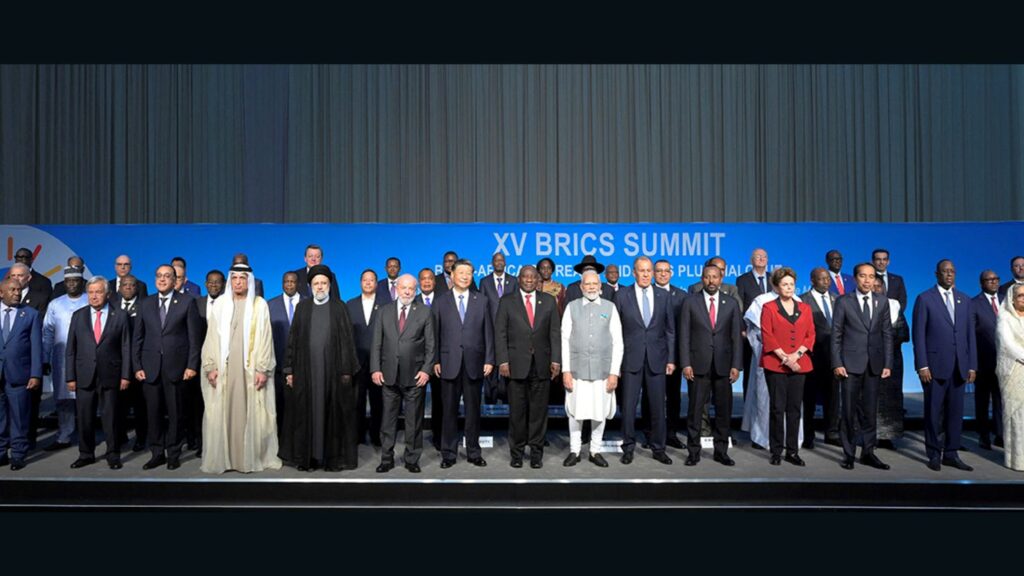The investment gap
Over the past three decades, South Africa’s fixed investment — spending on physical assets such as factories, machinery, and infrastructure — has averaged just 16 percent of GDP. This is roughly half the average for upper-middle-income economies. Chronic underinvestment in the real economy, where most jobs are created, has contributed to the steady decline of South Africa’s manufacturing sector both as a share of GDP and in employment. Reversing this trend will require a massive increase in fixed investment. The government has recognised this and set an ambitious target to increase total investment from 14 percent to 25 percent of GDP by 2030. Yet, the question remains: how this increase will be achieved — and at what cost.
The Myth of Blended Finance
The government’s strategy relies heavily on blended finance and concessional loans — loans with below-market interest rates. Since 2021, South Africa has significantly increased total borrowing from international finance institutions – such as the World Bank for instance, as well as so-called development finance institutions including the French Development Bank and German Development Bank. Most recently the European Union (EU) pledged a € 11,5 billion “investment package” with South Africa. 75 percent of this (€8,7 billion) is in the form of blended financing – combining public and private sector investments. The deal also comes with commitments from South Africa to provide the EU with critical minerals required to transition to a low-carbon economy. At first glance, blended finance appears to leverage private capital for public benefit. In reality, however, it often disguises public debt as private investment. Infrastructure projects branded as “privately financed” are, in practice, funded largely by taxpayers and service users through government guarantees, subsidies, and cost-reflective tariffs.
De-risking = guaranteed profits
At the heart of the blended finance model lies the concept of “de-risking” private investment. This involves lowering a project’s cost of capital through government-backed guarantees, tax incentives, or regulatory reforms that make projects more “bankable” for investors. The experience of such financing models globally shows that they can end up being more expensive for the public than traditional public borrowing. Complex public–private partnership (PPP) contracts provide numerous opportunities for cost inflation, opaque pricing, and rent-seeking behaviour. Far from reducing the fiscal burden, these arrangements often socialise risk and privatise profit.
In practice, de-risking shifts the burden of uncertainty and loss from private investors to the public sector. Governments assume the early-stage investment risks in infrastructure and research and development (R&D) by providing loan guarantees, subsidies, and regulatory changes that remove perceived barriers to private participation. The outcome is predictable: the private sector collects guaranteed profits, while taxpayers absorb the losses when projects fail. De-risking is therefore less a strategy for shared risk, than a mechanism for insulating private capital from normal market risks — all under the rhetoric of partnership and sustainability.
In addition to the financial derisking of private sector investments – the government has also been unfolding a process of regulatory de-risking – this is removing barriers that obstruct private players including through unbundling state-owned enterprises thereby dismantling vertically integrated public utilities in energy and transport for example.
Alternative financing for Reindustrialisation
An alternative to blended finance and concessional lending would be to increase domestic resource mobilisation including through the use of pension systems by shifting the investment portfolios from equity to government bonds that could be ring-fenced for infrastructural investment. This could be through the reintroduction of “prescribed assets”, requiring every pension fund to place a prescribed minimum of its total investments in both government bonds and various public assets. This system was ended in 1989 after it was introduced in the Pensions Fund Act of 1956. It was compulsory for every fund to invest at least 10 percent of its total assets in government stock and another 40 percent in prescribed stock (which also included government stock).
The government should also look to implement a tax on excess non-financial company’s cash holdings. South Africa’s non-financial companies (NFCs) held a record R1.8 trillion in their bank accounts in July 2025. If South Africa implemented a moderate tax on excess corporate cash holdings—say a 3 percent levy on 30 percent of the estimated R1.8 trillion held by non-financial companies—it could raise approximately R16 billion annually. While this approach will not raise sufficient revenue to finance a reindustrialisation strategy, it would contribute to encouraging fixed investments.
Another way to reduce the cost of borrowing, toward stimulating investment, would be through the South African Reserve Bank (SARB). Currently that SARBs mandate prioritises price stability, but a more balanced approach could include employment and developmental objectives. This would enable the SARB to lower interest rates and expand concessional lending to low-carbon, labour-intensive industries, aimed at stimulating reindustrialisation and domestic demand. This would ensure greater alignment of South Africa’s monetary policy with broader social and economic goals — much like developmental central banks in Brazil, South China, and India.
Conclusion
Reindustrialising South Africa will not be achieved through creative accounting or financial engineering. It demands strategic public investment, democratic control of finance, and a renewed commitment to productive transformation. Fortunately, South Africa has extensive resources that can be mobilised to finance a reindustrialisation programme for the country, there is no need to turn to international finance institutions nor to increase the level of foreign debt.











